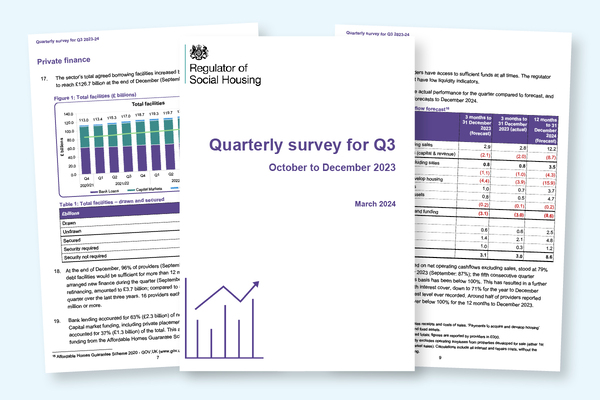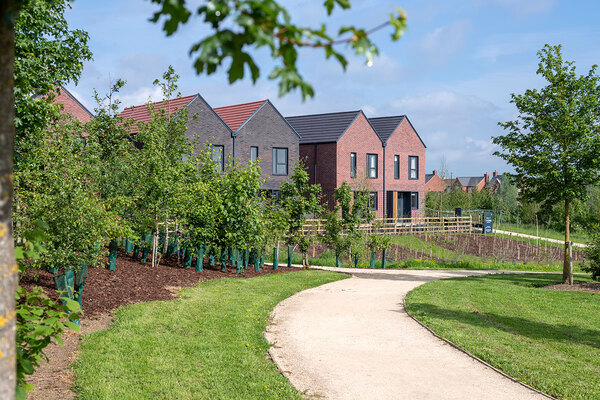You are viewing 1 of your 1 free articles
Landlords seeking loan carve-outs to meet external pressures and restructuring legacy debt
An increasing number of social landlords are seeking loan carve-outs and are restructuring legacy debt as the sector navigates a challenging economic climate.
The economic pressure comes as a host of major landlords have dialled down their development plans in the face of other financial priorities, such as building safety and decarbonisation.
Earlier this week, ratings agency S&P outlined its prediction in a new report that total debt in the UK social housing sector will increase to £120bn in the next two years as more landlords return to the capital markets.
At the same time, the English regulator’s latest quarterly survey of private registered providers’ financial health found that interest cover has fallen for the third quarter in a row to the lowest level ever recorded as landlords continue to increase spending on new and existing homes.
Annual aggregate cash interest cover (excluding all sales) fell to 71%, although it is expected to rise slightly to 80% over the next year.
Inside Housing has spoken to a number of financial experts who explained that for the most part, loan covenants are not in danger of being breached, rather treasury directors are taking a pragmatic approach in the face of competing pressures.
Gary Grigor, a partner at Devonshires, said: “We’re seeing a lot of requests for covenant carve-outs among our client base. Providers have no choice other than to meet their legal and regulatory requirements and incur the additional expenditure on their housing assets.
“It’s not necessarily that covenants will be breached, but in a lot of cases this erodes the buffer that RPs [registered providers] would otherwise want to maintain to ensure covenant compliance, which is just a little bit too close for comfort.
“The prudent approach being adopted by treasurers is to tackle this head on and lock in a degree of certainty now, while managing the expectations of external stakeholders in their business.”
He said lenders and investors are engaging with pragmatism and support for their customers as there is a general recognition across the board that the expenditure must be incurred.
Mr Grigor added: “It’s ultimately in nobody’s interest to slow down that process that could otherwise jeopardise the worthiness of the housing assets.
“I think this is one of the factors that is continuing to forge further mergers and partnerships across the RP community, where in some cases the required level of spend and delivering on tenant needs is more comfortably achieved by reaching a critical mass.”
Lucy Grimwood, a partner at Winckworth Sherwood, said pressure has been mounting over the past few years, in particular since the end of 2021, with landlords seeking fire safety carve-outs and now with disrepairs, decarbonisation and building safety as chief concerns.
She added: “These pressures have all increased in volume due to post pandemic build-up, alongside legislative and regulatory changes, resulting in borrowers and lenders working together to achieve carve outs to a greater degree than before.
“Both lenders and borrowers in our experience have worked collaboratively to agree on these in order to mitigate the challenge of meeting financial covenants due to the costs of those regulatory commitments increasing by way of inflation, labour costs and supply chain issues.
“While the carve-outs therefore have certainly increased, it is more a case of necessity than an increased receptiveness of lenders to such carve-outs. Most borrowers have a solid working relationship with their main funders and both sides appear to be committed to finding solutions that work for both parties.”
This increased pressure is likely to remain for most of the rest of the decade according to Housemark. A report by the data company in January found that housing associations’ operating margins have fallen 30% in the past five years and will remain tight until the mid to late 2020s.
Richard Conway, a member of the real estate team at Chatham Financial, agreed that “borrowers are not simply renegotiating in response to potential loan covenant breaches, but to provide flexibility for investment in existing stock and to maintain prudent treasury management”.
He explained: “In addition to loan amendments, notably covenant renegotiations, we have seen a marked increase in the restructure of legacy fixed rate loans and derivatives to reduce short-term interest costs.
“We have worked with clients to negotiate permanent or temporary optimised covenants definitions, primarily interest cover tests, that exclude major repairs or carveout-specific expenditures including fire and safety, damp, energy efficiency, and other environmental costs.
“Even at tighter test thresholds, redefined covenants generate meaningful capacity and aid prudent treasury management.”
Mr Conway said he believes nearly all banks active in the sector are amenable to more business-friendly covenants, such as EBITDA (earnings before interest, taxes, depreciation and amortisation)-only based interest cover. However, each lender is taking a nuanced approach to defining key tests, with some more receptive than others.
He added: “Covenant renegotiations are driving programmatic re-financings across the sector, helping associations unlock capacity to mitigate the challenging economic environment and respond to rising capital expenditures.
“Looking forward, we see borrowers aiming to replace any temporary covenant test carve outs with permanent market facing terms to optimise treasury portfolios. This may coincide with opportunities to restructure legacy fixed rate loans for interest savings.”
Inside Housing reported in December how rising rates have impacted the appetite for the sector’s debt on bond markets. A number of experts explained that housing associations that are waiting for gilt rates to fall could find themselves in competition with each other due to reduced investor appetite.
Sign up for our development and finance newsletter
Already have an account? Click here to manage your newsletters












